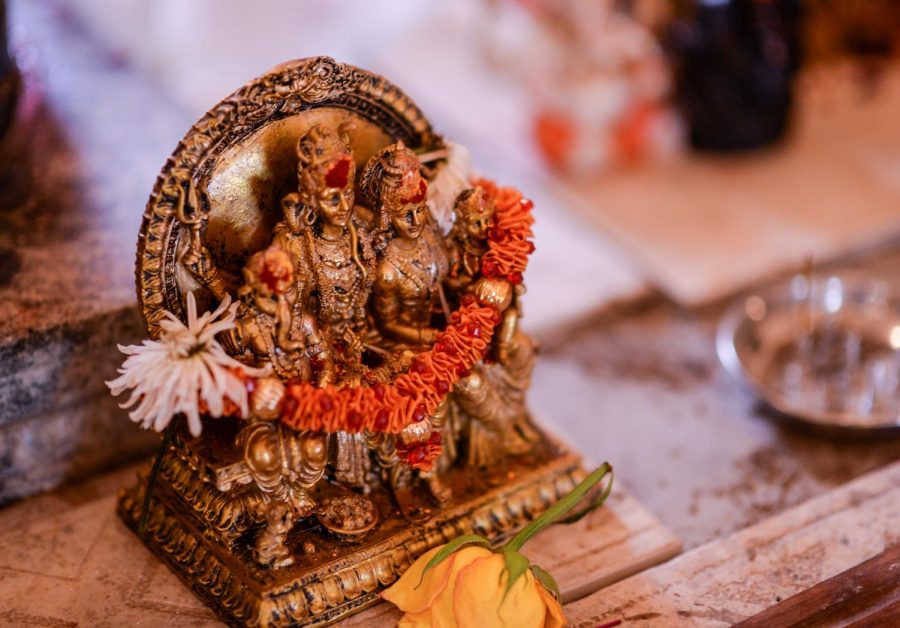Pullman Ashram hosts Diwali night
Only Indian Hindu temple in area decorates, worships in celebration of light
The Pullman Ashram prayer room is decorated with several idols in celebration of Diwali on Saturday night.
November 12, 2019
The Palouse Indian Family Association hosted a Diwali celebration Saturday night at the Pullman Ashram.
Sarangamat Gurusiddaiah, former WSU professor and founder of the Pullman Ashram, said he had been preparing for the event since early Saturday morning. At around 1:30 p.m. he was still drilling screws into the walls so he could hang strings of lights.
Gurusiddaiah climbed on top of tables and chairs while he was decorating. He said he might be old, but he can still get things done.
He said he was unsure how many people would show up later that day for the event. He said there have been as little as 20 people and as many as 120 people attend in previous years.
The ashram is the only Indian Hindu temple in Pullman, Gurusiddaiah said. The next nearest temple is in Tri-Cities.
He said began building the ashram around the year 2007 after his retirement. He said has put all his money into its construction and is still building parts of the ashram.
After hanging the lights across the walls, Gurusiddaiah entered the worship room on the far side of the ashram.
The floor in the worship room was covered by four large carpets. There were four bells hanging from a horizontal beam in the ceiling. In the front of the room, there was a table covered in statues and unlit candles.
After entering, Gurusiddaiah rang a bell and began praying alongside a single, long note.
“The prayer is the sound of the light,” Gurusiddaiah said later.
He turned to the right and rang the next two bells before walking over a small gong near the right side of the room. He used a small mallet to hit the gong and continued his prayer and hit the gong a couple more times.
Gurusiddaiah walked over to a sink and counter where he pulled a stick of incense from a box and lit it, waving the stick above the table full of statues and candles.
“It’s just incense,” he said. “It has a calming effect on the mind.”
Gurusiddaiah placed the still burning stick of incense in a holder on the table and walked over to a small table which was in front of the larger table full of statues.
He scooped a spoonful of raisins and dried mango from a bowl on the small table into his palm. He covered the bowl again and walked over to the right side of the room where he sat in one of the chairs.
Diwali is the celebration of light, so before there was anything in the universe, there was light, he said. He said light is not philosophy or religion — it is a celebration.
“Light is the first thing in the formation of the universe,” he said.
Light is in everything and everything is made of light, Gurusiddaiah said. He said everyone should feel welcome to celebrate Diwali, regardless of their religion.
“God is one and God’s names are many,” he said. “All of them are the same. They all mean the same.”
The celebration began around 6 p.m. All the lights across the walls were lit and three children in matching traditional wear where dancing and playing with a red balloon.
Deepika, an attendee at the event and mother of the three children in matching outfits, said the religious background behind celebrating Diwali involved a war between good and evil. She said the war lasted for around 14 years.
Anurag Srivastava, PIFA president, and Niraj Shah, PIFA vice president, said Diwali celebrates good’s victory over evil in the war.
Srivastava said Diwali is several days long, and the main celebration takes place on a day where the moon is not visible. Shah said the number of days Diwali is celebrated by a family depends on which region of India the family comes from.
On a table placed across a wall, several women and children were separating grains into paper bowls and tearing petals off different colored flowers.
Nidhi, an attendee at the celebration, said the flowers and grains would be used to make rangoli, which were art pieces created of patterns and usually spread across the floor.

Several women create a Rangoli made of flower petals and seeds on the floor on Saturday night at Pullman Ashram.
There were two rangolis made of sand already on each side of the room in the ashram. Those two had been there for a while, according to Gurusiddaiah.
A group of children were sitting at table painting small, brown mud bowls.
Nidhi said the bowls were called diya and were used as candles. She said oil will be poured in the diya and small pieces of cotton will be placed in the oil and lit on fire.
Around 7 p.m. the rangoli had been created, the diya were painted and drying and chairs were placed across the middle of the room.
A keyboard piano was set up in front of the chairs and a very young child sat on a tall chair to perform a melody of songs. She recited the ABCs which she followed by singing Baa Baa Black Sheep and Twinkle Twinkle Little Star.
The child’s performance was followed by a young boy playing a violin. His act was then followed by a slighty older boy who performed some magic tricks.
The boy’s tricks involved making three yellow balls appear and disappear under three grey cups as well as reading the mind of an audience member to correctly guess the number the audience member was thinking of.
Another performance was given by a girl who recited some poetry.
Each child received a prize at the end of the performances. Then, attendees lined up to serve themselves from the several dishes provided by different attendees. Participants moved the chairs around so it was easier to talk to each other while eating.
After dinner ended, a table was set up and several Bingo cards were passed out.
Across the room, the worship room was visible through a set of glass windows. The table full of statues was also covered in a couple of dried flowers that were laying between the statues and the flames of several candles flickered on and around the table.
















